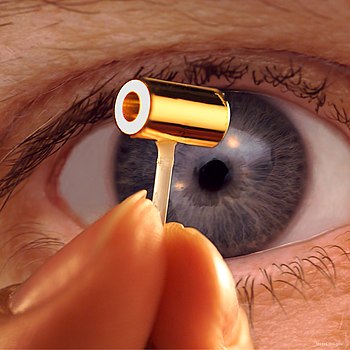 |
| NIF flashlamps (Photo credit: Wikipedia) |
 |
| English: Laser Bay 2, one of NIF's two laser bays (Photo credit: Wikipedia) |
 |
| Mockup of a gold-plated hohlraum designed for use in the National Ignition Facility (Photo credit: Wikipedia) |
 |
| English: Upper portion of the NIF's target chamber under construction. The large square beam ports are prominent. (Photo credit: Wikipedia) |
 |
| English: The Beamlet laser, a scientific prototype of one of the NIF’s 192 beamlines, that has been operating at LLNL since 1994. (Photo credit: Wikipedia) |
 |
| English: Outside view of the Tokamak Fusion Test Reactor (Photo credit: Wikipedia) |
 |
| English: Layout of the NAtional Ignition Facility. Image taken from a LLNL publication. (Photo credit: Wikipedia) |
Not to sound scientist-like, I stop here.
Read on...
-----
BY KENNETH CHANG
LIVERMORE, California – Fusion, the process that powers the sun, is the dream of many – safe, nonpolluting and almost boundless. Here at Lawrence Livermore National Laboratory, where the primary focus of fusion work involves nuclear weapons, many scientists talk poetically about how it could end the world’s addiction to fossil fuels.
“It’s the dream of the future, solving energy,” said Stephen E.Bodner, who worked on fusion at Livermore in the 1960s and ‘70s, recalling that the military focus then was a ruse to keep government money flowing to the lab for energy research. “Everyone was winking,” he said. “Everyone knew better.”
The basic concept behind fusion is simple: Squeeze hydrogen atoms hard enough and they fuse together in helium. A helium atom weighs slightly less than the original hydrogen atoms, and by Einstein’s equation E=mc2, that liberated bit of mass turns into energy. Hydrogen is so abundant that unlike fossil fuels or fissionable material like uranium, it will never run out.
Scientists have never figured out a way to keep a fusion reaction going long enough to generate usable energy. The running joke is that “fusion is 30 years in the future – and always will be.”
Now, however, scientists here have given the world some progress. In February, a team headed by Omar A. Hurricane said it had used giant lasers to fuse hydrogen atoms and produce flashes of energy, like miniature hydrogen bombs. The amount of energy produced was tiny – the equivalent of what a 60-watt light bulb consumes in five minutes.
The fusion occurred at the National Ignition Facility, which has cost $5.3 billion to build and operate. The key to the facility is ignition. For government purposes, ignition was defined as a fusion reaction producing as much energy as the laser beams that hit it. To achieve that, an initial smidgen of fusion has to cascade to neighboring hydrogen atoms.
The center of NIF is the target chamber, a metal sphere 10 meters wide with gleaming equipment radiating outward. It looks like something from “Star Trek” – in fact it doubled as the engine room of the Enterprise in last year’s “Star Trek Into Darkness” movie.
Each blast starts with a small laser pulse that is split via mirrors into 192, then bounced through laser amplifiers that fill two warehouse-size rooms. The beams are then focused into the chamber, converging on a gold cylinder the size of a pencil eraser. In a brief moment, the imploding atoms fuse together.
The scientists call it bang time.
Each shot is so short that the cost in electricity is just $5.
Livermore officials were confident enough that NIF would achieve ignition soon after it was turned on that they laid out a plan for building a demonstration power plant they said could be ready for electrical grids by the 2030s.
Dr. Bodner, who had left Livermore in 1975 and set up a competing program at the Naval Research Laboratory, was a critic of NIF. In 1995, he predicted that instabilities in the imploding gas would thwart ignition. He championed a different laser fusion concept in which the lasers shine directly on the fuel pellets. That creates other technical difficulties. Dr. Bonder, who retired in 1999, said his team was able to show those could be overcome.
The sun’s immense gravity provides the squeeze that enables fusion. On earth, there are two main possibilities: powerful lasers to jam the hydrogen together, as at NIF, or magnetic fields to contain a hot hydrogen plasma until the atoms collide and fuse.
Most fusion energy research has focused on the magnetic approach, particularly doughnut-shaped machines known as tokamaks.
In 1994, the Tokamak Fusion Test Reactor at Princeton University in New Jersey generated 10.7 million watts of power for a brief moment. Three years later, the Joint European Torus in England topped that, at 16 million watts.
The next step in the magnetic route is a mammoth international collaboration known as Iter. Construction on Iter has begun in southern France, with the first operations expected to begin in the 2020s – if it comes together. Under a complex management structure, the partners in the project (the European Union, Japan, China, Russia, the United States, India and South Korea) agreed to contribute pieces of the reactor, with the central Iter organization attempting to coordinate.
But the recent progress has come in the laser path to fusion.
Dr. Hurricane adjusted the laser pulse to warm the gold cylinder initially. That reduced the implosion pressure that had been tearing the pellet apart, but calmed some of the instabilities, yielding a higher rate of fusion.
In September, Dr.Hurricane’s team had its first shot that showed signs of the fusion reaction spreading through the fuel.
Jeff Wisoff, NIF’s acting director, said, “Now we at least have a sparking match.”
Taken from TODAY Saturday Edition, March 29, 2014







0 comments:
Post a Comment